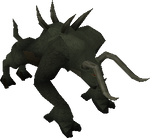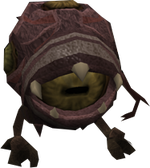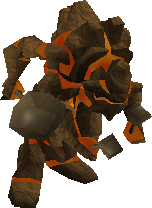Languages
Many languages are spoken, or have been spoken, throughout the world of Gielinor. Though most characters speak a language usually referred to simply as the "common tongue,"<ref>Jagex. "God Letter 16 - Guthix Dispels Rumours, Letter 5." RuneScape god letters. *</ref><ref name="GuthixReiterates">Jagex. "God Letter 25 - Guthix Reiterates, Letters 4, 6." RuneScape god letters. *</ref> many more are encountered by the player, or are referred to by other characters. According to Postie Pete, there are over 1000 languages spoken in Gielinor.<ref>Postie Pete, "Castle Wars", RuneScape. "So would you be if you could speak over 1000 languages." *</ref>
The common tongue is spoken by the vast majority of Gielinor's races and nations. Although many races do possess their own languages and dialects, many of these have been forgotten or been made rarer in recent years. This may be partially due to the more peaceful relationships between civilizations since the Fourth Age, when interaction between many races became more common.
Because the frequent use of many different languages would negatively effect gameplay, the common tongue is presented to the player in the language they themselves select when logging in, such as German or French.
Known languages
Ancient Dwarvish tongue

The ancient dwarvish tongue is the traditional language of the dwarves, a subterranean race found throughout Gielinor. Its modern use varies by region. In the more industrial, modernized parts of the Dwarven Realm, such as the capital city of Keldagrim, the dwarven tongue is no longer commonly spoken. However, the language was spoken by the dwarves of Keldagrim before they fled beneath the surface of Gielinor during the God Wars, and remained the dominant language for centuries, such as during the Age of Kings. As a result, most of the city's ancient documents are written in the ancient dwarvish tongue, and so it is still known to scholars and historians.
In some parts of the Dwarven Realm, such as the Ice Mountain Dwarven Colony, the ancient dwarvish tongue is used to a slightly larger degree, although it is known that by Year 164 of the Fifth Age it had mostly given way to the common tongue. In the novel Betrayal at Falador, Master Phyllis, an extremely elderly resident of the Colony, often spoke in Ancient Dwarvish. Kara-Meir, the girl discovered by Phyllis and his clan in the Year 155, was named "Wolf Cub" in the dwarvish tongue because she was found resting in the butchered body of a wolf.<ref>T.S. Church. Betrayal at Falador, (67). Babel Interactive Ltd., 2008.*</ref>
Another word known to come directly from the ancient dwarvish tongue is Hugi, which literally means "personification of thought."<ref>Librarian, RuneScape. "Hugi, my parents named me that, it means 'personification of thought' in the ancient dwarvish tongue." *</ref> The word itself has found use as a name amongst the dwarves such as is the case with the Librarian of Keldagrim Library.
The Sacred Forge of Camdozaal is known to have been activated with the chant Bron Uffon Afgi Bami prior to the hall's destruction during the Runecrafting Crusades that took place during the Years 42 to 62 of the Fifth Age. Ramarno, one of few Imcando Dwarf to survive the Battle of Camdozaal, is seen using the chant during the Defender of Varrock quest. However, it is unclear if the phrase is drawn from the dwarvish tongue or from another language. The phrase, when spoken backwards, spells "I'm a big fan of FunOrb."
Common tongue
The common tongue is the language spoken by the vast majority of Gielinor's inhabitants. It is often associated with humans, suggesting it may have originated with them; however, nearly all of Gielinor's inhabitants have adopted it, at least to some extent, and speak it when necessary. Humans and other races are known to have spoken the common tongue since the First Age, evidently having brought it with them from another world.
In issue 25 of the God Letters, Guthix suggests that the common tongue has developed greatly over the course of Gielinor's history, pointing out that the names of modern cities such as Avarrocka and Farradorn have died out relatively quickly.<ref name="GuthixReiterates">Jagex. "" RuneScape god letters. *</ref> There are a wide variety of dialects in the common tongue; for instance, most ogres, trolls, and goblins all speak what seem to be simplified versions of the common tongue.
Elvish language
| “ | ...the elvish language, on the other hand, is far more complex, for their tongues are as agile as their minds, and twice as bewildering. | ” |
— Reldo
|

The elves have a complex language that even the greatest human scholars can not completely comprehend. Their language was one of the first to exist in Gielinor, as the elves were brought by Seren to Gielinor via the World Gate in the early Second Age. They brought it with them from their homeworld, although it is unclear where this was. Even before most other races had had arrived in Gielinor, the elves had a mastering of the common tongue, as is seen during the dialogue of Haluned during the Meeting History quest.<ref>Haluned, "Meeting History", RuneScape. "We are not alone in these lands. I must report./These must be the humans Guthix spoke of./There are other beings in this world!" *</ref> It is unclear whether they spoke this before they arrived, or learned it once in Gielinor. No human is known to understand the elvish language more than pronunciation approximations.<ref>Jagex. Postbag 35 - "But how do you pruh-nounce Rell-doh?", Letter 4. Postbags from the Hedge. *</ref> The art of Crystal Singing is also deeply rooted in the elvish language, although the exact relationship between the two is unclear.
The elvish tongue is similar in many ways to the real-life Welsh language; the name of the elven capital is Prifddinas, which translates to "capital" in Welsh. Other elvish words drawn from the Welsh language include Tirannwn, Isafdar, Lletya, and Cerddi.
Feline language
Cats are an intelligent race of felines with their own languages. They were brought into Gielinor by Guthix, who presumably taught them how to communicate. However, due to limitations in human comprehension, all words spoken by cats are interpreted as "meow" by humans. In order to communicate with cats, the clergy of Sophanem created the catspeak amulet, which made it possible for humans to communicate with cats, and vice versa. Certain felines (such as the Sphinx) can be understood without a catspeak amulet, which may mean that they can speak the common tongue.
Goblin language
Prior to their arrival in Gielinor, the goblin race is known to have spoken a language separate from that of the common tongue. The ancient goblin language originated in Yu'biusk, a separate world within the multiverse. After being forcibly brought to Gielinor in the Second Age by the deity Bandos, the race retained this language for some time. However, the goblins gradually adopted a simplified version of the common tongue. In the modern day, the language is nearly forgotten. The Dorgeshuun of Dorgesh-Kaan have studied the language, and have documented it to a degree.
The goblin language is known to have been spoken by some Misthalanian and Asgarnian goblins as recently as the early 700's of the Fourth Age. Arrav, a legendary Fourth Age soldier of Avarrocka, earned his name from a curse in the goblin tongue.<ref>Jagex. "The Legend of Arrav, Part I, Section 2." RuneScape Lores and Histories. *</ref> Some of the few goblin words still in use are the names of the 12 goblin tribes, such as the Thorobshuun and Garagorshuun.
Kurask language

The Kurasks have a basic language, known to the human world thanks to Skuhavi, a Kurask banished for his interest in humans.<ref>Jagex. Postbag 23 - "Wise old musings and demonic drills", Letter 5. Postbags from the Hedge. *</ref> The Kurask language has eight known words, many of which are related to Kurisk, the rite of passage attempted by all Kurask at age 80. The language became known to humans when Skuhavi replied to an adventurer's letter using Kurask words.
Mahjarrat language
The Mahjarrat race is known to possess a language of its own,<ref>Jagex. Postbag 38 - "What's the matter, Jad? Chicken?", Letter 5. Postbags from the Hedge. *</ref> which it brought to Gielinor from Freneskae in the Second Age. Perhaps because the race has been so deeply involved with other races during its time in Gielinor, the Mahjarrat are usually observed to speak the common tongue, even amongst themselves.
The only word known to have been directly derived from the Mahjarrat language is that of their home world, Freneskae. However, it is extremely difficult to approximate the language in the common tongue, and so alternate spellings and pronunciations such as Feneskrae, Freneskrae or Freneskæ have been used in the past.
As described in The Fall of Six, the Mahjarrat Sliske re-animated the corpses of the Barrows Brothers during the Third Age by chanting "in some foul, ancient language, casting his old magic."<ref>Jagex. "The Fall of Six, Ruination." RuneScape Lores and Histories. *</ref> It is probable that this spell was cast in the Mahjarrat language, again indicating its potency in magic.
Menaphite language
The Menaphite people of the Kharidian Desert are known to possess their own unique language. Given the long history of the Menaphites, it is highly possible that the Menaphite language is one of the oldest in Gielinor. Hieroglyphs representing the Menaphite language can be found in temples, pyramids, and other structures throughout the desert.
The holy book of the Menaphite Pantheon, the Book of Light and Day,<ref>Sphinx, RuneScape. "The Book of Light and Day says that Tumeken once fell into a deep sleep and dreamt for four days and four nights." *</ref> is traditionally written in the Menaphite language. According to Reldo, the librarian of Varrock Castle, the High Priest of Icthlarin recently sent him an excerpt of the text depicting Tumeken's Dream, which was written in "Menaphosian."<ref>Jagex. "Tumeken's Dream, Reldo's Comments." RuneScape Lores and Histories. *</ref> It is probable that this is related to, if not synonymous with, the greater Menaphite language.
Monkey language
Gielinor's monkey population possesses an advanced language that is unintelligable to most, if not all, other races. The monkeys that inhabit Karamja and Ape Atoll both speak identically, whereas the Harmless species native to Mos Le'Harmless speaks a slightly simplified version. By wearing a monkeyspeak amulet, it is possible to understand the monkey language.
Old Gnomish
Old Gnomish is a language traditionally spoken the gnome race. It was used regularly by the gnomes of the Gnome Empire up until the late Fourth Age, when the race began to experience more regular interaction with other races.<ref>Jagex. "God Letter 26 - Saradomin Preaches, Letter 8." RuneScape god letters. *</ref> Today, most gnomes still speak Old Gnomish, but the common tongue has largely become the dominant language of the race. Many Old Gnomish terms have been made common knowledge via the translation book found during The Grand Tree quest.
Instances of the language's modern use can be found throughout the Gnome Empire; for instance, gnome glider pilots still use maps bearing Old Gnomish text. Hazelmere, a gnome hero of the late Fourth Age, was known to regularly speak the language even into the modern day. The language may draw some influence from the Latin language, as at least one Old Gnomish term, Anima Mundi, is a Latin phrase meaning "the soul of the world."
Skavid language
The skavids of Feldip Hills, in addition to understanding and speaking the human tongue, also possess a language of their own. The skavids were the indigenous race of Feldip Hills, but were driven nearly to extinction by Bandos during the Third Age, and forced into servitude by their ogre masters. This language is used by the skavids so that the ogres cannot understand them. During the Watchtower quest, an adventurer is taught the skavid language by a scared skavid underneath Gu'Tanoth. There are only ten known words in the language, but they are enough to communicate with other skavids.
Stalker language

The Stalker race that was brought to Daemonheim by the Mahjarrat Bilrach speaks a highly complex language that only they understand. Not unlike the Mahjarrat language, the Stalker language will physically harm most races if heard. The combination of audible and inaudible sounds produced by Stalkers speaking their language is known to cause heavy bleeding from the nose and severe headaches, even in brief periods of exposure.<ref>Stalker notes (part 1), RuneScape. "The resultant combination of both audible and inaudible sound from its many lipless mouths gave me a huge headache and caused blood to cascade from my nose" *</ref>
When necessary, Stalkers also are known to use the common tongue. The names they give themselves in the common tongue are often complicated because of the complexity of their own language, as can be observed in the names of Stalkers such as Lakhrahnaz, Khighorahk, and Haasghenahk.
TzHaar language

The TzHaar that inhabit Karamja Volcano still regularly speak the TzHaar Language,<ref name="Postbag14">Jagex. Postbag 14 - "The woeful tale of the bunny ears.", Wise Old Tips. Postbags from the Hedge. *</ref> which was developed by the race during their long isolation during the Second, Third, and Fourth Ages, while they remained isolated from the surface. Since the race re-established open contact with the surface in the Year 169 of the Fifth Age, the language has been studied by humans, although thus far with only minor success. According to Postie Pete, words in the TzHaar language are based more around the passion and emotion behind the word, rather than the literal translation.<ref name="Postbag12">Jagex. Postbag 12 - "Rats, Pirates and the Wise Old Man!", Wise old tips. Postbags from the Hedge. *</ref> Many TzHaar terms have been revealed in the past, most either through the Wise Old Man's translations in the Postbags from the Hedge<ref name="Postbag14">Jagex. Postbags from the Hedge. *</ref><ref name="Postbag12">Jagex. Postbags from the Hedge. *</ref> or via the Tzhaar tourist guide found during the TokTz-Ket-Dill quest.
The TzHaar are unique in that they possess the ability to pass their knowledge directly on to their ancestors. As a result, the minimal contact they had with the surface during their almost complete isolation was enough so that several TzHaar were able to learn the common tongue.<ref>Jagex. "The Excellent Log of the Journeys and Tribulations of Samuel Scourduel, Part II, Section 2." RuneScape Lores and Histories. *</ref> This has been passed on to the TzHaar of today, who will speak the common tongue to those visiting the city.
Werewolf language
The werewolf race that inhabits Morytania is known to speak their own language aside from the common tongue. According to the werewolf Jerrod, a character in the RuneScape novel Betrayal at Falador, young werewolves are only taught the common tongue when they reach adulthood, and until then speak only the werewolf language.<ref>T.S. Church. Betrayal at Falador, (258). Babel Interactive Ltd., 2008.*</ref> As the werewolves that inhabit Canifis are only observed to speak the common tongue, it is unclear when the language is used by adults. Gar'rth, Jerrod's nephew, was as of the Year 164 of the Fourth Age only capable of speaking the werewolf language.
Wyvern language
According to Postie Pete, the wyvern species possessed a language of its own prior to its extinction during the Fourth Age. Given their close relationship to dragons, it is probable that the language was derived at least partially from that of dragons or the dragonkin. Given that the wyvern race was largely unintelligent, it is likely that the language is fairly simple. Postie Pete claims to speak wyvern, implying that it has not completely died out.